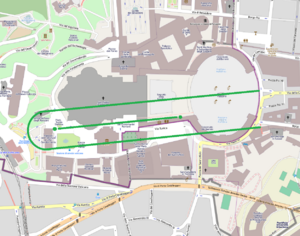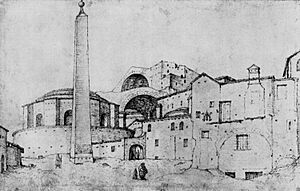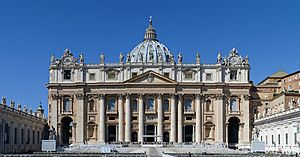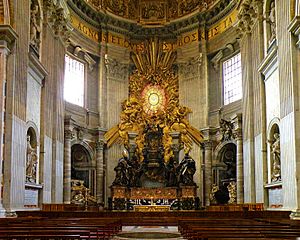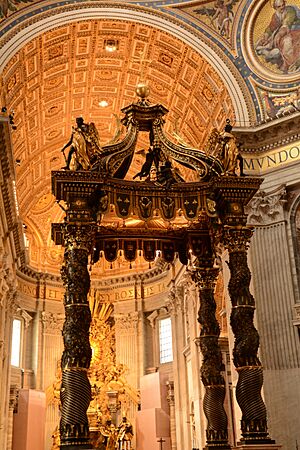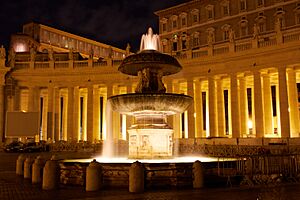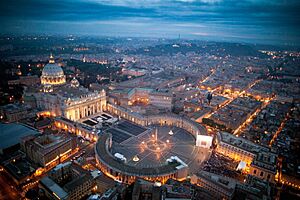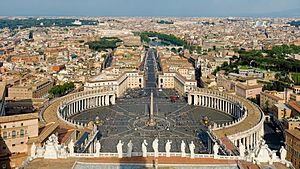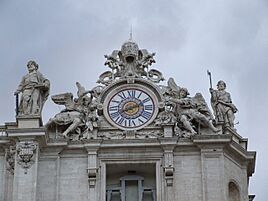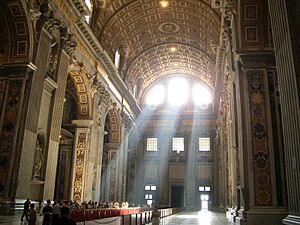St. Peter's Basilica facts for kids
Quick facts for kids St. Peter's Basilica |
|
|---|---|
| Papal Basilica of Saint Peter in the Vatican | |
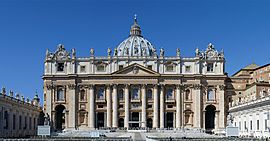
|
|
| 41°54′08″N 12°27′12″E / 41.90222°N 12.45333°E | |
| Country | Vatican City |
| Denomination | Catholic |
| Tradition | Roman Rite |
| History | |
| Status | Papal major basilica |
| Dedication | Saint Peter |
| Consecrated | 18 November 1626 |
| Architecture | |
| Architect(s) |
|
| Style | Renaissance and Baroque |
| Groundbreaking | 18 April 1506 |
| Completed | 18 November 1626 |
| Specifications | |
| Capacity | 60,000 standing and 20,000 seated |
| Length | 220 metres (720 ft) |
| Width | 150 metres (490 ft) |
| Height | 136.6 metres (448 ft) |
| Nave height | 46.2 metres (152 ft) |
| Dome diameter (outer) | 42 metres (138 ft) |
| Dome diameter (inner) | 41.5 metres (136 ft) |
| Administration | |
| Diocese | Rome |
St. Peter's Basilica is a very famous church in Vatican City. Vatican City is a tiny country located inside Rome, Italy. This amazing building was designed by famous artists like Donato Bramante, Michelangelo, and Carlo Maderno. Its large square and decorations were created by Gian Lorenzo Bernini.
St. Peter's Basilica is one of the most important examples of Italian Renaissance architecture. It is also the largest church in the world based on its inside size. Even though it's not the main church for the Catholic Church (that's the Archbasilica of Saint John Lateran), it is considered one of the holiest Catholic places. Many people call it "the greatest of all churches of Christendom."
Catholic tradition says that Saint Peter, one of Jesus's main followers and the first Pope, is buried here. His tomb is believed to be right under the main altar of the basilica. Because of this, many popes and other important church leaders have been buried at St. Peter's for a very long time.
St. Peter's is a popular place for pilgrims and for important church events. The Pope often leads services here or in the nearby St. Peter's Square. These events can attract huge crowds, sometimes over 80,000 people! The basilica has a rich history, connected to the early Christian Church, the Popes, and many famous artists like Michelangelo. It is truly a masterpiece of architecture from its time.
St. Peter's is one of four special churches in Rome called major papal basilicas. It is not a cathedral because it is not the main church of a bishop.
Contents
Exploring St. Peter's Basilica

St. Peter's Basilica is built in the Renaissance style. It is located in Vatican City, west of the Tiber River. Its huge dome is a famous part of Rome's skyline. To reach the basilica, you walk through St. Peter's Square. This square has two parts, both surrounded by tall colonnades (rows of columns). The first part is oval, and the second is shaped like a trapezoid.
The front of the basilica, called the façade, has giant columns. Steps lead up to it, with two large statues of Saints Peter and Paul on either side. Each statue is about 5.55 meters (18 feet) tall.
The church is shaped like a Latin cross, which means it has a long main section (nave) and shorter arms (transepts). However, the first designs were for a central, round building, and you can still see hints of that in the architecture. The center of the building, both inside and out, is dominated by one of the largest domes in the world. Inside the dome's four huge support pillars are giant statues. These statues represent four important holy relics believed to be kept in the basilica: St. Longinus with his spear, St. Helena with the True Cross, St. Veronica with her veil, and St. Andrew.
You enter the basilica through a large entrance hall called a narthex. One special bronze door in this hall is the Holy Door, which is only opened during special "Jubilee" years.
The inside of St. Peter's is incredibly huge. It's so big that people look tiny next to the monuments and decorations. This makes you feel how grand the building is.
The main part of the church, the nave, leads to the central dome. It has three sections with huge arches. Wide aisles run alongside the nave, with many smaller chapels branching off them. There are also chapels around the dome. The entire inside of St. Peter's is beautifully decorated with marble, sculptures, and gold. It holds many tombs of popes and other important people, which are also considered great works of art.
One of the most famous artworks is Michelangelo's Pietà. The main feature in the center is a baldachin, a large canopy over the Papal Altar, designed by Gian Lorenzo Bernini. At the very back of the church, in the apse, is another amazing sculpture by Bernini, which holds the symbolic Chair of Saint Peter.
The American philosopher Ralph Waldo Emerson once called St. Peter's "an ornament of the earth... the sublime of the beautiful."
Why St. Peter's is Special

St. Peter's Basilica is the most important building in Vatican City. Its dome is a key part of Rome's skyline. It covers an area of about 0.139 hectares (0.34 acres). It is one of the holiest places for Christians and Catholics. As tradition says, it is the burial place of St. Peter, who was a leader among Jesus's followers and the first Pope.
Even though the New Testament doesn't say Peter was killed in Rome, tradition says his tomb is under the baldachin and altar in the "Confession" area. Because of this, many Popes have been buried near St. Peter in the ancient cemetery below the basilica.
Building the current basilica, on top of an older one, started on April 18, 1506. It was finished in 1615. On November 18, 1626, Pope Urban VIII officially dedicated the new basilica.
St. Peter's Basilica is not the Pope's official main church. That honor belongs to the Archbasilica of St. John Lateran. However, St. Peter's is where most Papal ceremonies happen. This is because it is very large, close to the Pope's home, and located within Vatican City. The "Chair of Saint Peter" is an ancient chair that symbolizes the Popes' connection to St. Peter. It is placed high up in the back of the basilica, supported by statues of important church thinkers.
Because of its history and amazing architecture, St. Peter's Basilica was named a World Heritage Site by UNESCO in 1984. It is the largest Christian church building in the world by its interior size. Its dome, at 136.6 meters (448.1 feet), is also the tallest dome in the world.
History of the Basilica
Saint Peter's Burial Site
After Jesus's death, the Bible says that Saint Peter, a fisherman, became a leader among Jesus's followers. He was very important in starting the Christian Church. The name Peter means "stone" or "rock."
Catholic tradition says that Peter traveled to Rome and was killed there around 64 AD, during the time of the Roman Emperor Nero. He was crucified upside down, as he felt he was not worthy to die in the same way as Jesus. This happened near an ancient Egyptian obelisk in the Circus of Nero. This obelisk now stands in St. Peter's Square and is seen as a "witness" to Peter's death.
Tradition says Peter was buried just outside the Circus, on the Vatican Hill. A small shrine was built there later. About 300 years after that, the Old St. Peter's Basilica was built over this spot. The area around Vatican City was a cemetery even before the Circus of Nero. Many Christians chose to be buried near St. Peter.
In 1939, during the time of Pope Pius XII, archaeologists began searching under the basilica. They found remains of shrines from different periods, built over a small structure containing bone fragments. These bones were wrapped in a special cloth with gold decorations. While it's not certain these were Peter's bones, the rare cloth suggests a very important burial. On December 23, 1950, Pope Pius XII announced the discovery of Saint Peter's tomb.
The Old St. Peter's Basilica
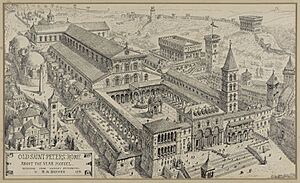
The Old St. Peter's Basilica was a church started by Emperor Constantine the Great between 319 and 333 AD. It was a typical basilica shape, with a wide main section and two aisles on each side. It was over 103.6 meters (340 feet) long. This church was built over the small shrine believed to mark St. Peter's burial place. It held many burials, including most of the popes up to the 15th century.
Planning the New Building
By the late 1400s, the old basilica was falling apart. Pope Nicholas V (1447–1455) was the first pope to think about rebuilding it. He hired architects to work on the old building and design a new one. However, he faced political problems, and not much was done before he died.
Pope Julius II had much bigger plans for St. Peter's. He wanted to build a huge new church to hold his own tomb and make himself famous. In 1505, he decided to tear down the old basilica. A competition was held for the new design. Many popes and architects worked on the project over the next 120 years, leading to the building we see today.
To pay for the new St. Peter's Basilica, money was raised through contributions. This method of fundraising caused some debate and was one of the reasons for the Protestant Reformation.
Digital Versions of the Basilica
Recently, the Vatican has started using digital copies of the Basilica. This helps people learn about it and experience it without visiting in person. In 2024, the Vatican worked with Microsoft to create an interactive 3D model. This model was made using over 400,000 high-quality photos taken by drones and artificial intelligence.
In 2025, the Vatican also worked with Microsoft to create another interactive version of the Basilica. This one was made in the video game Minecraft. This Minecraft map, called "Peter is Here," was created for the 2025 Jubilee to connect with young people.
Architecture and Design
Changing Plans for the Dome
gallery mode="packed" heights="200px" style="text-align:center;" File:SaintPierre.svg|Bramante's plan, a Greek cross with a central dome. File:L’Architecture de la Renaissance - Fig. 8.PNG|Raphael's plan, which added a longer nave. File:L’Architecture de la Renaissance - Fig. 13.PNG|Michelangelo's plan, returning to a bolder Greek cross. /gallery
Pope Julius II wanted the grandest church in Christendom. Many designs were submitted, and Donato Bramante's was chosen in 1506. His plan was for a huge Greek cross shape with a dome inspired by the ancient Roman Pantheon. Unlike the Pantheon, Bramante's dome would rest on four large pillars.
When Pope Julius died in 1513, other architects took over. Raphael became the architect in 1514. He changed the plan to have a longer nave (the main part of the church) with chapels along the sides.
Raphael died in 1520, and Baldassare Peruzzi took over. He went back to Bramante's Greek cross plan. However, this plan didn't happen because of problems in the Church and the state. Rome was attacked in 1527, and Peruzzi died in 1536.
Then, Antonio da Sangallo the Younger proposed a plan that combined ideas from earlier architects. He also suggested a more detailed dome design. Sangallo's most important contribution was strengthening Bramante's pillars, which had started to crack.
On January 1, 1547, Michelangelo, who was in his seventies, became the main architect. He is considered the most important designer of much of the building as it stands today. He didn't want the job but was forced to take it by the Pope. He insisted on having complete freedom to design as he saw fit.
Michelangelo's Work
Michelangelo took over a building site where four enormous pillars were rising. He also had to consider the many designs from the past 40 years. All these designs included a dome as grand as the one in Florence Cathedral and a symmetrical plan, either a Greek cross or a Latin cross.
Michelangelo didn't ignore the previous ideas. He used them to create his own grand vision. He went back to the Greek cross shape. As art historian Helen Gardner said, he made the complex design into a "massive, cohesive unity."
Today, St. Peter's has a longer nave added by Carlo Maderno. But the back part of the church, with its huge central dome, is Michelangelo's work. Because of the long nave, you can't see the dome from the front square. You need to view it from a distance to truly appreciate Michelangelo's design.
Michelangelo made the outside walls look very strong and filled in every corner with small rooms or stairwells. This makes the building look like a continuous, folded wall. Giant Corinthian pilasters (flat columns) are placed at different angles, matching the changing angles of the wall. Above them, a huge cornice (a decorative molding) seems to squeeze the whole building together.
The Dome: Designs and Completion
The dome of St. Peter's reaches a total height of 136.57 meters (448.1 feet) from the floor to the top of the cross. It is the tallest dome in the world. Its inside diameter is 41.47 meters (136.1 feet). It's slightly smaller than the domes of the Pantheon and Florence Cathedral, which came before it.
gallery mode="packed" heights="190" style="text-align:center;" File:Roma S.Pietro in Vaticano (zzf).jpg|Bramante's dome design. File:Roma S.Pietro in Vaticano (zzg).jpg|Sangallo's detailed design. File:Speculum Romanae Magnificentiae- Elevation Showing the Exterior of Saint Peter's Basilica from the South as Conceived by Michelagelo (Published in 1569) MET DT203424.jpg|An engraving of Michelangelo's dome design from 1569. /gallery
Bramante's plan for the dome (1506) was very similar to the Pantheon's. It was designed to be built from a type of concrete. Sangallo's plan (1513) looked at both the Pantheon and Florence Cathedral. He made Bramante's design stronger and more detailed.

Michelangelo redesigned the dome in 1547. His dome has two brick shells, with 16 stone ribs on the outside. It is raised on a drum (a circular wall) above the main pillars. Michelangelo's design for the dome was more oval-shaped than perfectly round.
Michelangelo died in 1564, leaving the drum of the dome finished. The work continued under Jacopo Barozzi da Vignola. In 1585, Pope Sixtus V appointed Giacomo della Porta and Domenico Fontana to finish the dome. They completed it in 1590.
The dome's oval shape has been studied a lot. Michelangelo's early drawings show an oval dome. It's thought that this shape helps the dome look like it's pushing upwards, creating a feeling of tension and strength. This design also hints at the Baroque style that came later.
In the mid-1700s, cracks appeared in the dome. Iron chains were installed between the two shells to hold it together, like the rings on a barrel.
Around the inside of the dome, in letters 1.4 meters (4.6 feet) high, it says:
TV ES PETRVS ET SVPER HANC PETRAM AEDIFICABO ECCLESIAM MEAM ET TIBI DABO CLAVES REGNI CAELORVM
("... you are Peter, and on this rock I will build my church. ... and I will give you the keys of the kingdom of heaven ... Vulgate, Matthew 16:18–19.)
Beneath the lantern (the small structure at the very top of the dome) is another inscription:
S. PETRI GLORIAE SIXTVS PP. V. A. M. D. XC. PONTIF. V.
(To the glory of St Peter; Sixtus V, pope, in the year 1590, the fifth of his pontificate.)
A drawing of the dome by Michelangelo was found in the Vatican archives on December 7, 2007. Michelangelo was known to destroy many of his drawings, so this was a rare find.
On February 18, 1606, under Pope Paul V, the remaining parts of the old Constantinian basilica were taken down. The Pope appointed Carlo Maderno in 1602. He was a talented architect.
The Church leaders decided to extend Michelangelo's building by adding a long nave. This was partly because they felt guilty about tearing down the ancient church. They wanted the new building to cover the same holy ground. Also, the Counter-Reformation movement preferred the Latin cross shape, which symbolized Christianity, over the Greek cross.
Maderno's plans for the nave and the front of the church (facade) were accepted. Building the nave began on May 7, 1607, with 700 workers. The facade started the next year. By early 1615, the nave was ready for use.
Maderno's Facade
The facade designed by Maderno is 114.69 meters (376.3 feet) wide and 45.55 meters (149.4 feet) high. It is made of travertine stone. It has giant Corinthian columns and a central triangular top (pediment). On top of the roofline are thirteen statues: Christ in the center, flanked by eleven of the Apostles (except Saint Peter), and John the Baptist.
An inscription on the facade reads:
IN HONOREM PRINCIPIS APOST PAVLVS V BVRGHESIVS ROMANVS PONT MAX AN MDCXII PONT VII
(In honor of the Prince of Apostles, Paul V Borghese, a Roman, Supreme Pontiff, in the year 1612, the seventh of his pontificate)
Many people think the facade is the least successful part of St. Peter's design. It is very wide for its height, and its details seem a bit crowded. Its width is partly because towers were planned on either side, but they were never built above the facade because the ground wasn't strong enough. The long facade and nave also block the view of the dome from the front.
Bernini's Towers
Pope Urban VIII was not happy with Carlo Maderno's design for the long nave, which hid Michelangelo's dome. So, he asked Bernini to design new bell towers for the facade. Bernini's design included two levels of columns and a third attic level.
The Pope wanted the towers finished by June 29, 1641. The south tower was completed on time. However, the Pope was still not satisfied and ordered changes. As the tower grew, cracks started to appear. In 1642, all work on the towers stopped. Bernini had to pay for the demolition, and the idea of completing the bell towers was given up.
Entrance Hall and Doors
Behind the facade is a long entrance hall called a "narthex" or portico. Maderno was very proud of this part of his design. Its long arched ceiling is decorated with beautiful stucco and gold, lit by small windows. The marble floor shines with light from the square outside.
At each end of the narthex is a large statue: an equestrian statue of Charlemagne (18th century) by Cornacchini on the south side, and The Vision of Constantine (1670) by Bernini on the north side.
Five doors lead from the narthex into the basilica. The central door is a bronze door made by Antonio Averulino around 1440 for the old basilica. It was made larger to fit the new space. The southernmost door, called the Door of the Dead, was designed by Giacomo Manzù in the 20th century.
The northernmost door is the "Holy Door." By tradition, this door is sealed with bricks and only opened by the Pope for special "holy years" or Jubilee years. The current bronze door was designed by Vico Consorti in 1950. Above it are plaques remembering when the door was opened by different Popes.

Maderno added three more sections to Michelangelo's Greek Cross design, creating the long nave. He made these sections slightly different in size to show where his work met Michelangelo's. Maderno also slightly tilted the nave's axis. This was done on purpose to align with an ancient Egyptian obelisk in the square outside.
The nave has huge paired pilasters, matching Michelangelo's style. The inside of the building is so big that it's hard to understand its scale. For example, the four cherubs holding holy water basins look normal-sized until you get close. Then you realize each one is over 2 meters (6.6 feet) tall!
The aisles next to the nave have smaller chapels. These are richly decorated with marble, stucco, gold, sculptures, and mosaics. Most of the large paintings in the altars have been copied in mosaic. Two old paintings from the original basilica are still used as altarpieces.
Maderno's last work at St. Peter's was designing a crypt-like area called the "Confessio" under the dome. This is where cardinals and other important people can go to be closer to St. Peter's burial place. It has marble steps from the old basilica and 95 bronze lamps around its railing.
Influence on Other Churches
The design of St. Peter's Basilica, especially its dome, has greatly influenced church architecture in the Western world. Many churches in Rome and other cities around the world have domes and designs inspired by St. Peter's. Examples include St Paul's Cathedral in London, the Karlskirche in Vienna, and the Pantheon in Paris.
In the 1800s and early 1900s, many churches were built that copied parts of St. Peter's. Even modern buildings like the Basilica of Our Lady of Licheń and the Basilica of Our Lady of Peace of Yamoussoukro show its influence.
Bernini's Furnishings and Artworks
Pope Urban VIII and Bernini
Gian Lorenzo Bernini (1598–1680) was a famous architect and sculptor. As a young boy, he dreamed of building a "mighty throne for the apostle" in St. Peter's. His dream came true. In 1626, he started working for Pope Urban VIII and spent 50 years decorating the Basilica. He became known as the greatest artist of the Baroque period. Bernini's works at St. Peter's include the baldachin, the Chapel of the Sacrament, and the Chair of Saint Peter.
The Baldachin and Niches
Bernini's first major work at St. Peter's was the baldachin. This is a huge, pavilion-like structure, 28.74 meters (94.3 feet) tall, made of bronze. It stands under the dome and above the main altar. Its design was inspired by canopies carried over the Pope in processions.
Bernini used eight ancient twisted columns from the old basilica as inspiration. He created four huge bronze columns for the baldachin, decorated with laurel leaves and bees (the symbol of Pope Urban). The baldachin has a draped bronze canopy, with gold leaf details. It is a massive sculpture that connects the huge dome above it with the people on the floor.
As part of his plan for the central area, Bernini had the huge pillars supporting the dome hollowed out. He created niches (recesses) and staircases inside them, leading to four balconies. On these balconies, Bernini created special displays, framed by the ancient twisted columns, to show four important relics: the Holy Lance (said to have pierced Christ's side), the veil of Veronica (with an image of Christ's face), a piece of the True Cross, and a relic of Saint Andrew. In the niches below, large statues of the saints connected to these relics were placed. Only the Saint Longinus statue was made by Bernini.
Chair of St. Peter and Chapel of the Blessed Sacrament
Bernini then focused on another important relic, the Cathedra Petri or "throne of St. Peter." This chair was believed to have been used by the apostle. Since the chair was old and fragile, Pope Alexander VII decided to house it in a grand way. Bernini created a large bronze throne to hold it. This throne is raised high on four supports, held by massive bronze statues of four important church thinkers: Saints Ambrose and Augustine (representing the Latin Church) and Athanasius and John Chrysostom (representing the Greek Church). These figures look very active and full of emotion.
Behind and above the chair, a bright light shines through a yellow alabaster window. In the center of this light is the Dove of the Holy Spirit. The chair was placed in its new home with a big celebration on January 16, 1666.
Bernini's last work for St. Peter's, started in 1676, was decorating the Chapel of the Sacrament. He designed a small, gilt-bronze version of Bramante's Tempietto (a small chapel) to hold the sacramental Host. On either side of it is an angel, one looking in worship and the other welcoming the viewer. Bernini died in 1680 at the age of 82.
St. Peter's Square
East of the basilica is the Piazza di San Pietro, or Saint Peter's Square. The current design, built between 1656 and 1667, was created by Bernini. The square already had an Egyptian obelisk in the center, which Maderno had aligned with the basilica's facade.
The obelisk, known as "The Witness," is 25.31 meters (83 feet) tall. Including its base and the cross on top, it reaches 40 meters (132 feet). It is the second largest standing obelisk and the only one that has remained standing since it was brought from Egypt and placed in the Circus of Nero in 37 AD. It is believed to have witnessed the crucifixion of Saint Peter. Moving it to its current spot in 1586 was very difficult.
Bernini also had to work around a large fountain designed by Maderno in 1613, which was to one side of the obelisk. Bernini's clever plan created a square with two sections. The part closest to the basilica is trapezoid-shaped, but it actually narrows as it gets closer to the church. This makes the facade look closer and taller than it is.
The second part of the square is a huge oval area that gently slopes down to the obelisk in its center. These two areas are framed by a colonnade (a row of columns) made of doubled pairs of columns.
The colonnade around the oval part doesn't completely encircle it. Instead, it reaches out in two arcs, symbolizing the "arms of the Catholic Church reaching out to welcome its members." The obelisk and Maderno's fountain mark the widest part of the oval. Bernini added another fountain in 1675 to balance the design.
In the past, you would approach the square through a maze of old buildings, which made the sudden view of St. Peter's even more surprising. Today, a wide street called the Via della Conciliazione leads from the River Tiber to the square. This street, built by Mussolini, gives you a distant view of St. Peter's as you approach.
Bernini's design for the square is a great example of Baroque art. While earlier architects wanted the building to stand alone, Bernini made the whole complex connect with its surroundings. As Banister Fletcher said, "No other city has afforded such a wide-swept approach to its cathedral church, no other architect could have conceived a design of greater nobility... (it is) the greatest of all atriums before the greatest of all churches of Christendom."
Clocks and Bells
The top of St. Peter's Basilica's facade has two clocks and several sculptures. The clocks were added after Bernini's bell towers had to be removed. The left clock shows Rome time, and the right one shows European mean time. The statues include Christ the Redeemer, St. John the Baptist, and 11 Apostles. Above the Roman clock is the coat of arms for Vatican City.
The Basilica has 6 bells, located in the room under the Roman clock. Only three are visible from the ground. They range in size from 235 kg (518 lbs) to a massive 9-tonne (20,000 lbs) bell called Campanone. Since 1931, the bells are operated electrically. The oldest bell, Rota, dates from 1353. The Campanone is rung on special holidays like Christmas and Easter, and when the Pope gives a blessing. It also announces the death of a Pope and the election of a new one.
Treasures and Artworks
Tombs and Relics
There are over 100 tombs inside St. Peter's Basilica, many located underneath. These include 91 popes, Saint Ignatius of Antioch, and the composer Giovanni Pierluigi da Palestrina. Some exiled British royals are also buried here, like James Francis Edward Stuart and his two sons. Other notable burials include Queen Christina of Sweden, who gave up her throne to become Catholic, and Countess Matilda of Tuscany. The most recent burial was Pope Benedict XVI on January 5, 2023.
Artworks to See
- Above the central outside door is a mosaic called the "Navicella." It is based on a design by Giotto from the early 1300s and shows a ship symbolizing the Christian Church. Most of the mosaic is a 17th-century copy.
- In the entrance hall (narthex), you'll find two large equestrian statues: Constantine the Great by Bernini (1670) and Charlemagne by Cornacchini (18th century).
- Of the five doors leading into the church, the central one has a Renaissance bronze door by Antonio Averulino (1455). The southern door, the Door of the Dead, was designed by 20th-century sculptor Giacomo Manzù.
- The "Holy Door" is the northernmost door. It is usually sealed with bricks and only opened by the Pope for special Jubilee years.
- In the nave, you'll see two Holy Water basins held by pairs of cherubs, each 2 meters (6.6 feet) tall.
- Markers on the floor of the nave show how long other famous churches are compared to St. Peter's.
- The pillars in the nave have medallions with reliefs of 56 early popes.
- In niches between the pillars are statues of 39 founders of religious orders.
- Against one of the dome's pillars is a statue of Saint Peter Enthroned. One of its feet is worn away from centuries of pilgrims kissing it.
- The sunken Confessio area under the dome has a large kneeling statue by Canova of Pope Pius VI.
- The main Altar is topped by Bernini's famous baldachin.
- In niches within the four pillars supporting the dome are large statues connected to the basilica's main holy relics: Saint Helena with the True Cross, Saint Longinus with the Holy Lance, Saint Andrew with his cross, and Saint Veronica with her veil.
gallery mode="packed" heights="200px" style="text-align:center;" File:Saint Helena.jpg|Saint Helena by Andrea Bolgi. File:Saint Longinus.jpg|Saint Longinus by Bernini. File:Saint Andreas.jpg|Saint Andrew by Francois Duquesnoy. File:Saint veronica.jpg|Saint Veronica by Francesco Mochi. /gallery
North and South Aisles
- In the first chapel of the north aisle is Michelangelo's famous Pietà.
- The second chapel, dedicated to Saint Sebastian, holds the statues of popes Pius XI and Pius XII. The remains of Pope John Paul II were placed here on May 2, 2011.
- The large chapel on the right aisle is the Chapel of the Blessed Sacrament, which has a tabernacle by Bernini (1664).
- At the end of the aisle is an altar with relics of Saint Petronilla and a painting by Guercino.
gallery mode="packed" heights="200" style="text-align:center;" File:Rome basilica st peter 004 adjusted.JPG|The Holy Door is opened only for great celebrations. File:0 Monument funéraire du pape Alexandre VII - St-Pierre - Vatican (1).jpg|The tomb of Alexander VII, by Gian Lorenzo Bernini, 1671–1678. File:Rome basilica st peter 011c adjusted.jpg|The bronze statue of Saint Peter holding the keys of heaven. File:Michelangelo's Pietà, St Peter's Basilica (1498–99).jpg|The Pietà by Michelangelo, 1498–1499, is in the north aisle. /gallery
- The first chapel in the south aisle is the baptistry, designed by Carlo Fontana. The font was carved from the lid of the purple stone sarcophagus that once held the remains of Emperor Hadrian.
- Against the first pillar of the aisle is the Monument to the Royal Stuarts, designed by Canova in 1819. It holds the tombs of James Francis Edward Stuart and his sons.
- The second chapel holds memorials to Pope Benedict XV and Pope John XXIII.
- The large chapel off the south aisle is the Choir Chapel.
- The tomb of Fabio Chigi, Pope Alexander VII, is a famous work by Bernini. It shows Pope Alexander kneeling on his tomb, which is supported by four female figures representing Charity and Truth. A skeletal figure of Death emerges from a doorway, holding an hourglass towards the Pope.
Key Facts About St. Peter's
- Total Length: About 222.5 meters (730 feet).
- Total Width: About 152.4 meters (500 feet).
- Internal Length (including entrance hall): About 211.5 meters (693.8 feet).
- Internal Height of Nave: About 46.2 meters (151.5 feet) high.
- Total Area: Over 21,095 square meters (5 acres).
- Height from ground to top of cross on dome: 136.6 meters (448.1 feet).
- Facade (front): 114.3 meters (375 feet) wide and 50.9 meters (167 feet) high.
- Dome's Outer Diameter: 42 meters (137.7 feet).
- St. Peter's Square: 340 meters (1115 feet) long and 240 meters (787.3 feet) wide.
- Colonnades (rows of columns) in the square: Each arm is 93.3 meters (306 feet) long and 19.5 meters (64 feet) high. They have 284 columns, 88 pilasters, and 140 statues.
- Obelisk in the square: 25.5 meters (83.6 feet) tall. Total height with base and cross is 40.2 meters (132 feet). It weighs about 360.2 short tons (326.8 metric tons).
Images for kids
-
A modern conjectural reconstruction of the relative locations of the circus, and the medieval and current Basilicas of St. Peter
-
A conjectural view of the Old St. Peter's Basilica by H. W. Brewer, 1891
-
St. Peter's Basilica from Castel Sant'Angelo showing the dome rising behind Maderno's façade
-
Bishops at the Second Vatican Council in 1962
-
Maderno's nave, looking towards the chancel, as painted by Giovanni Paolo Pannini, 1731
-
The tomb of Alexander VII, by Gian Lorenzo Bernini, 1671–1678
-
The bronze statue of Saint Peter holding the keys of heaven, attributed to Arnolfo di Cambio
-
The Pietà by Michelangelo, 1498–1499, is in the north aisle.
See also
 In Spanish: Basílica de San Pedro para niños
In Spanish: Basílica de San Pedro para niños
- Architecture of cathedrals and great churches
- Architecture of Rome
- History of early modern period domes
- List of tallest domes
- Index of Vatican City-related articles
- List of basilicas in Italy
- List of oldest church buildings
- List of Roman Catholic basilicas
- List of tallest buildings in Rome
- List of tallest structures built before the 20th century
- List of tourist attractions in Rome



